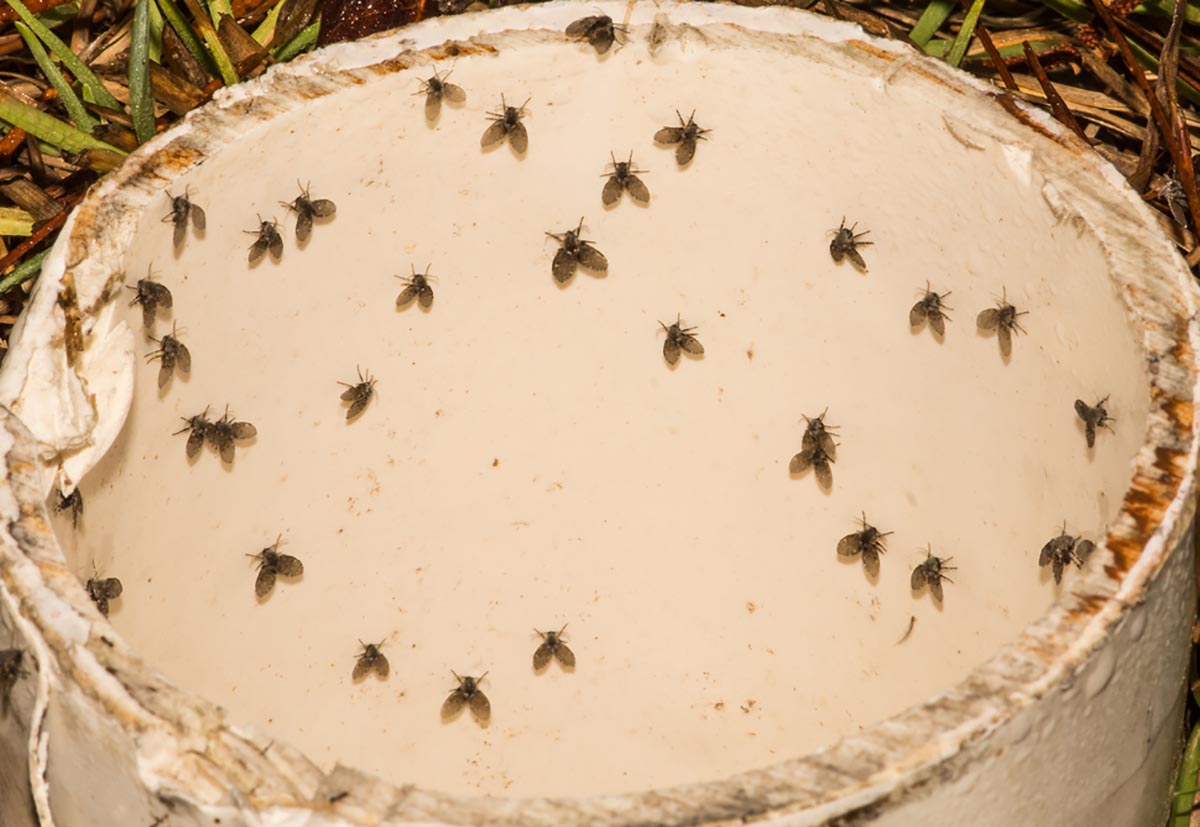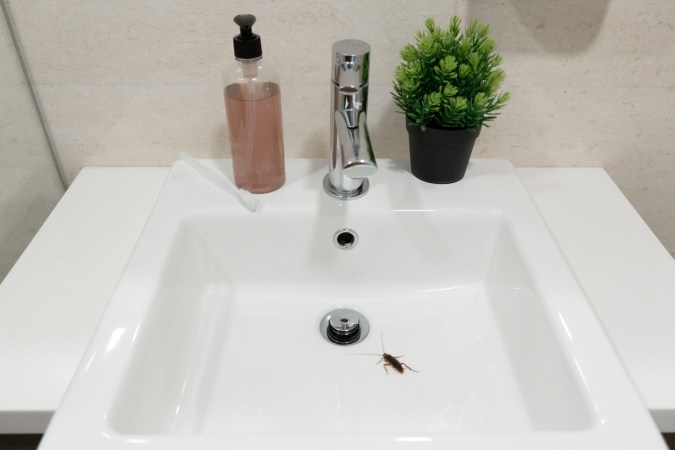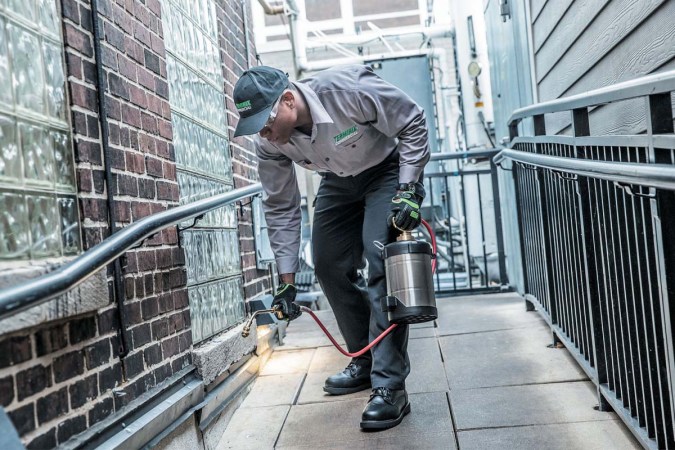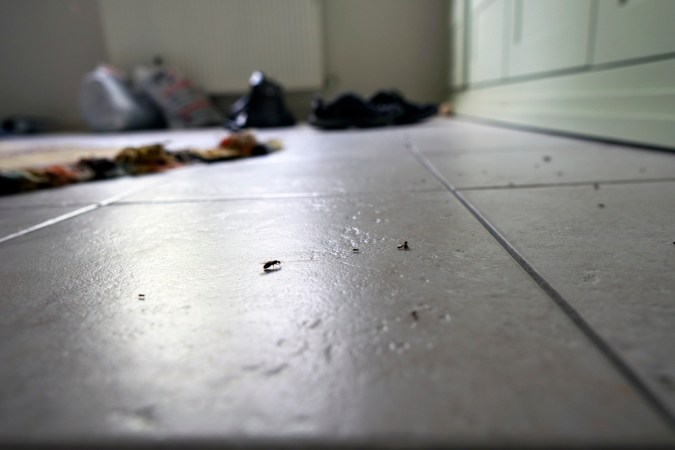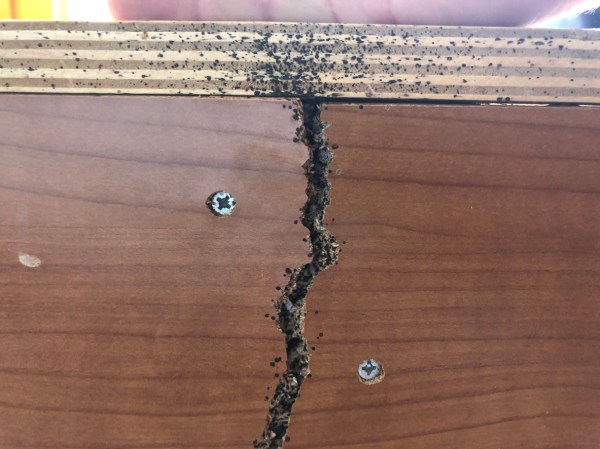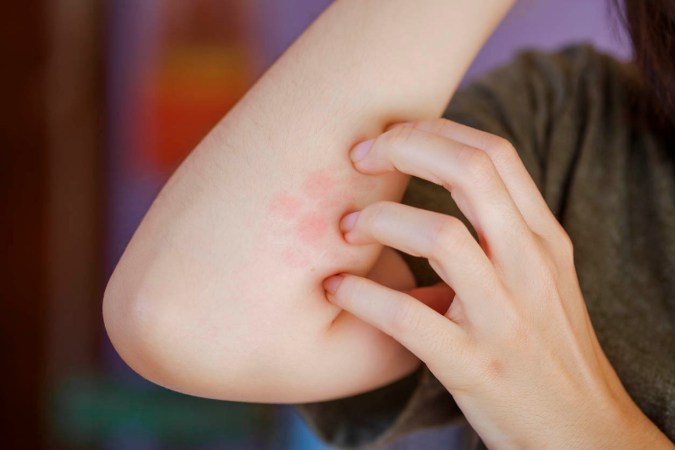We may earn revenue from the products available on this page and participate in affiliate programs. Learn More ›
Q: I keep seeing small black flying bugs in my house but they’re not fruit flies. What type of bug could they be, and how do I get rid of them?
A: The short answer is that these small black bugs in the house that aren’t fruit flies could be a number of different types of insects, from gnats to ants to flies. While gnat bugs are technically a form of fly, the term “gnat” is a term commonly used for any small flying insect and not a specific species of bug.
But no matter what bug you’re dealing with, there are ways to eliminate them and prevent them from coming back inside the home. In most cases, regularly cleaning the home and sealing any entry points around windows or doors are good ways to keep bugs out of the home. Removing any sources of excess moisture can also help. The guide below will help determine what type of flying bug is in the home and how to get rid of it.
| Type of bug | Size | Breeding site | Harmful to humans |
| No-see-um | Less than 1/8 inch in length | Shaded areas in marshes | Yes |
| Fungus gnat | 1/16 to 1/8 inch in length | Houseplants | No |
| Mosquitoes | 1/4 to 3/8 inch in length | Stagnant water | Yes |
| Drain flies | 1/8 inch in length | Decaying organic matter | No |
| Houseflies | 1/4 inch in length | Decaying organic matter | Yes |
| Phorid flies | 1/16 to 1/8 inch in length | Decaying organic matter | No |
| Flying ants | 3/4 inch in length | Wood | No |
| Flying termites | 1/4 to 3/8 inch in length | Wood | No |
Whether or not you are certain about the type of small black flying bug you’re dealing with, a professional from one of the best pest control companies can identify and treat the problem in no time. Orkin and Terminix are great options with a national footprint.
No-see-ums can inflict painful bites.
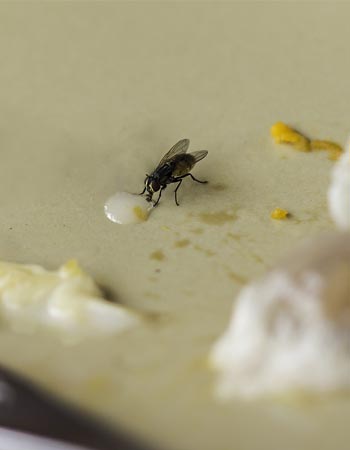
No-see-ums get their name from the fact that these insects are so small, they often go unnoticed. They are essentially extremely small flies, typically measuring less than 1/8 inch in length. They have a humpbacked appearance and are often gray or black in color. The female no-see-ums are the ones to watch out for, since they feed off blood to reproduce and can inflict painful bites on humans. They usually populate coastal areas and prefer to be near stagnant water around marshes and swamps. If there are tiny black bugs in the house near a window, they could be no-see-ums. When outdoors, people can protect themselves from these insects by wearing protective clothing and applying repellant.
- How to get rid of no-see-ums: As more agile fliers, no-see-ums are harder to eliminate than mosquitoes. However, it’s possible to keep them from coming inside the home by consistently running the air conditioning, using carbon dioxide mosquito traps, and installing window screens with a fine mesh to keep them from gaining entry inside. The traps work by exuding an attractant that brings the bugs near, then sucking them into a vacuum that they can’t escape. Finer mesh has smaller holes than a typical screen that a no-see-um could easily fly through.
Fungus gnats are typically found in soil and potting mix.
A fungus gnat is a small flying insect commonly found in and around houseplants, potted plants, and garden areas. Fungus gnats are attracted to moist environments and decaying organic matter, which is why plants and garden areas make an ideal space for them to inhabit. Plant lovers who spot gnats in the house could have a fungus gnat infestation. This is more likely to be true if the soil is overwatered or if it contains organic material. Although the gnats themselves aren’t harmful to plants, their larvae can feed on plant roots and cause stunted growth, yellow leaves, or plant decline.
- How to get rid of fungus gnats: Sticky traps are a good bet for removing fungus gnats from plants. Because these bugs have so many life stages, it’s necessary to capture and eliminate them at each one, which means trapping them is key. It’s also wise to keep an eye on how much the plants are watered and look for any other sources of moisture that may causing a gnat infestation.
Mosquitoes are typically gray with white, blue, or green scales, but they can appear black at a glance.
Known to bite humans and feed off their blood, mosquitoes are larger than brown or black fruit flies and have slender bodies with long, thin legs. They have one pair of transparent wings, with one on each side of their bodies. Although they are typically gray or brown in color, they can be mistaken for black from far away. These insects are often attracted to standing or stagnant water where they can lay their eggs, so any leaks or moisture can entice them to come indoors. The flying bugs can be pesky, so it’s best to act quickly if any signs of an infestation present themselves.
- How to get rid of mosquitoes: It’s not as common for mosquitoes to infest the inside of the home, but if they do, there are control measures to put in place to get rid of them. An indoor insect fogger is a good place to start; it contains pyrethrin or pyrethroid pesticides and aerosol propellants to spread a solution into the air. If there are pets or children in the home, it may be best to crack windows and doors while using an insect fogger or ensure everyone is out of the home while the fog is being pumped out. Other ways to control a mosquito population is to use air conditioning, install or repair window and door screens, and keep doors and windows closed so the bugs don’t gain entry. If the above methods don’t work, it might be a good idea to call one of the best mosquito control services to assess the issue and provide a treatment plan.
Drain flies, also known as sink flies or moth flies, lay eggs in areas of moisture or standing water.
Drain flies aren’t harmful to humans, but they can definitely be a nuisance. To manage these types of tiny flying insects, it helps to know where they like to hang around and lay their eggs, which can lead to an infestation. Drain flies are drawn to damp areas, which is how they got their name: think drains, moist basements, crawl spaces, sewage systems, and septic tanks. They tend to lay their eggs in organic matter that accumulates in those wet areas, and because they are weak fliers, they also stay near these spaces.
- How to get rid of drain flies: Drain flies often inhabit—you guessed it—household drains, so the first order of business when getting rid of them is to treat the sink and drain with a cleaning solution. A tube brush can be used to scrub inside and around the drain, then a drain-cleaning solution can be poured down the drain. If there are still tiny flying bugs in the house, another DIY eradication method is pouring apple cider vinegar in a bowl, wrapping it with plastic wrap, and poking holes in the top to trap and kill the flies. It’s also wise to look into calling one of the best drain cleaning services if the above steps don’t produce the desired results.
Houseflies are nuisance pests, but they can also carry diseases.
Although they may seem harmless, houseflies are known to carry pathogens such as bacteria, parasites, and viruses because of their contact with feces and other decaying material. In fact, flies can transmit harmful bacteria that can cause food poisoning, stomach cramps, diarrhea, and other illnesses. Some species of flies can even carry a form of bacteria that leads to dysentery, eye infections, and typhoid fever. With this in mind, it’s helpful to know how to get rid of little black flies in the home.
- How to get rid of houseflies: Because houseflies typically lay their eggs in decaying organic matter, the best way to get rid of these pests is to regularly empty or clean out garbage and compost pails and properly dispose of animal waste. It also helps to eliminate crumbs or other sources of food around the house as often as possible to keep from attracting small flies in the house. Tiny black flies in the house can also be prevented by repairing any damaged screens in windows or doors and sealing any gaps or cracks so the bugs can’t gain entry. If all else fails, it doesn’t hurt to try fly traps or flypaper that can capture flies. Natural repellents such as lavender or peppermint essential oils can also be effective in deterring little black flies in the bathroom or other spaces.
Phorid flies breed in damp, decaying material.
Also called humpbacked flies or scuttle flies, phorid flies are a type of small fly that has a hunched thorax. They measure about 1/16- to 1/8-inch in size and have two wings, each covered in short hairs. These tiny black flying bugs can be found inside homes or commercial buildings as well as outdoors. Phorid flies are sometimes referred to as scuttle flies because of their skittish movement across surfaces. They also don’t fly in a straight line and are known to have rapid, erratic movement patterns. This type of fly gravitates toward decaying organic matter in drains or garbage pails, which is also where they typically lay their eggs.
- How to get rid of phorid flies: As with other insects, the best way to get rid of phorid flies is to remove their breeding source. Since they lay their eggs in decomposing organic matter, it’s best to throw out any waste and clean out the garbage can, compost bin, and drains. Once this step is complete, soap and water or another household cleaner can be used to wipe any surfaces phorid flies have been on. A drain-cleaning solution also may need to be applied down the drain to eliminate any lingering bugs or breeding sources. Once the bug population has been controlled, preventive measures can be implemented such as sealing any large cracks or holes near entry points, repairing any leaks in plumbing or pipes, and setting up fly traps or baits.
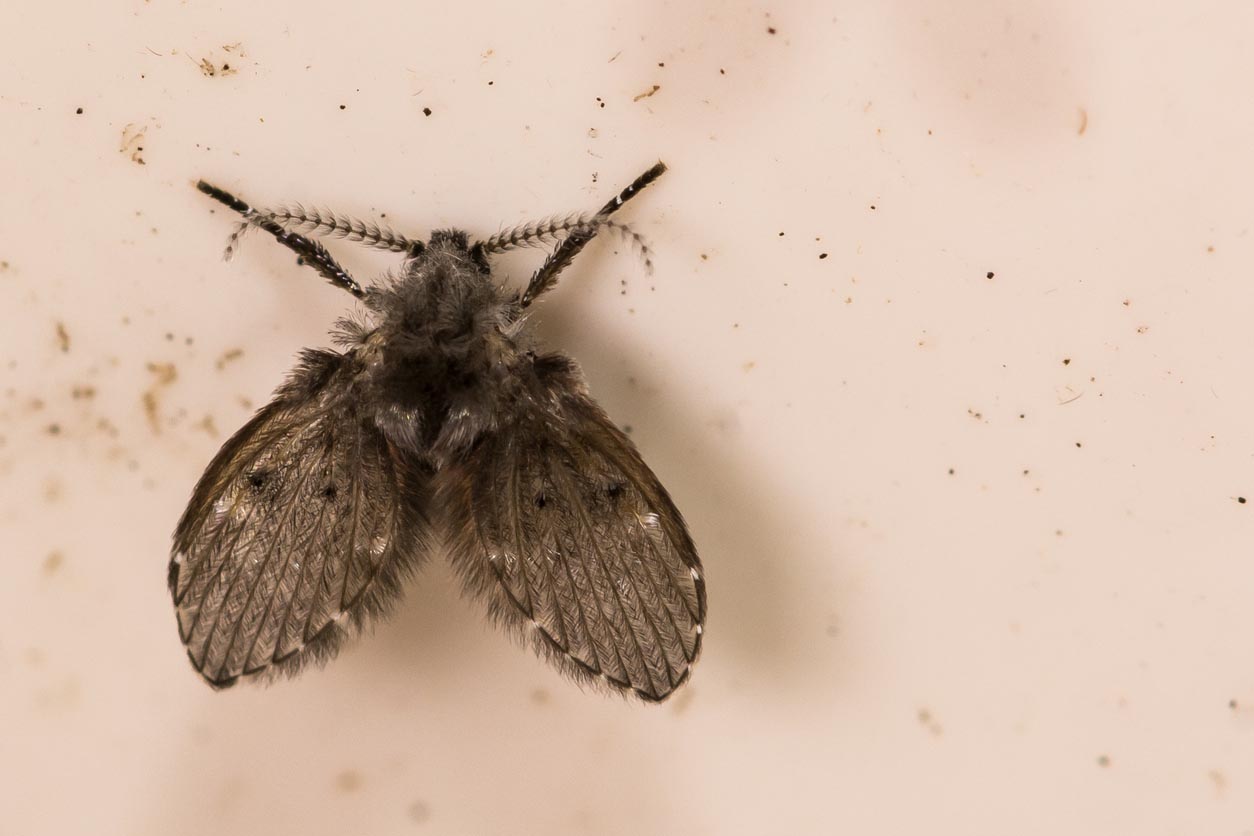
Flying ants are the reproductive members of an ant colony.
At first glance, it’s easy to mistake flying ants for carpenter ants, since they look so much alike. However, flying ants have a second set of wings, and their sole purpose is to reproduce. After mating, the female ants will shed their wings and find a new spot to colonize. Although they’re less likely to infest the inside of a home, they can be drawn to artificial light sources and exposed food, especially if the food contains sugar. Flying ants are often more active in the spring and summer, but this varies by region.
- How to get rid of flying ants: One way to get rid of flying ants is to reduce outdoor lighting around doors and windows. This can help keep flying ants away from the property and eliminate the risk of them entering the inside of the home. Another way to control a flying ant population is to clean up after eating outside to make sure no crumbs or debris remain that the ants could feed on. If the above methods don’t work and there is still an annoying ant problem, it may be time to call in the help of a professional. Pest control companies can assess the issue and come up with a treatment plan that will get rid of the insects for good.
Flying termites leave their original colonies to start new ones.
Because they play an essential role in establishing new termite colonies, flying termites can easily multiply and infest the space. The upside? These insects don’t damage or feed on wood, so they’re less detrimental to the actual property. However, they can be a sign of a termite infestation, in which case it’s best to enlist the help of the best termite control company. If discarded wings or a termite swarm are present, it’s best to act fast and have an expert provide an inspection. Other signs to look for include damaged wood, mud tubes, and evidence of worker termites.
- How to get rid of flying termites: Although it’s tempting to want to take matters into one’s own hands, termite elimination is best left to the professionals. The best termite control companies will be able to inspect the home and determine what type of treatment is necessary to get rid of the bugs. Treatment options could include bait stations, chemical treatments such as liquid termiticides, and in severe cases, structural fumigation. This includes covering the entire structure with a tarp and pumping a gas throughout the space to kill the termites.
FAQs
Answers to some of the most common gnat-related questions, from how long they live to how harmful they can be, can be found below.
Q. Are drain flies harmful?
No. Drain flies can’t bite, sting, or cause illness, but they may incite an allergic reaction in some people once they’re decaying.
Q. Why am I getting lots of little black flies?
You’re likely getting lots of little black flies if there are cracks or holes in the foundation, walls, windows, and doors or if they have easy access to moist spots near decomposing material.
Q. Do gnats lay eggs in humans?
No; the human body is actually inhospitable to gnats and their eggs.
Q. How long does it take for gnats to go away?
Gnats typically live about 4 weeks, but they reproduce at a rapid pace. The sooner you get rid of them, the less chance they’ll lay eggs and stick around.
Q. How do I find a gnat nest?
Look in moist places where you’ll usually find decomposing organic matter, such as trash cans, sinks, drains, or toilets.
Q. What’s the difference between fruit flies and gnats?
Fruit flies have a more rounded shape, similar to a fly, whereas gnats have long bodies and dangling legs that resemble those of a mosquito.

